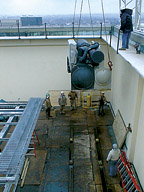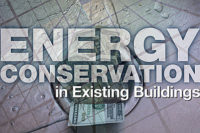

Existing Systems
In addition to replacing the chillers and cooling towers, other improvements to the mechanical systems were to be made. Installation plans included a DDC system to take control of the new chilled water plant as well as other portions of the overall environmental control system.The building had a large central AHU that served the interior of the facility. This unit would get new controls and sensors and would be represented with graphics at the new DDC front end. The perimeter of the building was conditioned with console-style fancoil units. The controls for the fancoil units were not altered, but temperature sensors were installed at each of the four building exposures (north, south, east, and west) on several floors so that the building operators could anticipate changes that might have to be made to accommodate changes in weather. Fresh air was delivered to the perimeter zones through overhead diffusers fed from a 100% outside air ventilation unit located in the penthouse. This unit was in poor condition and would be replaced.
The site visit revealed that the existing chillers were not the ordinary variety. They were gas-engine driven centrifugal chillers original to the building. These two 400-ton chillers were enormous and were resting on 12-in. thick inertia bases for acoustical purposes. They were works of engineering art and were maintained in excellent working order by a mechanic that started at the facility shortly after it opened. It was evident that he took pride in the operation of this equipment. Remarkably, this man had faithfully preserved not only the construction drawings for the building, but the specifications as well, which proved invaluable during the design process. The engines were loud, and ear protection was required if any significant amount of time was to be spent in the mechanical room.
The original chillers were piped in series with each chiller selected on a 5° temperature drop with overall conditions of 55°F entering, 45° leaving. The chilled water system served both the interior and ventilation air handlers as well as the perimeter fancoil system. This perimeter loop was a two-pipe system and each of the four exposures were originally controlled to a common loop temperature, which doesn't work very well in mild weather and during sunny winter days. During the winter, when the low-lying Ohio sun decides to reveal itself, the southern exposure gets uncomfortably hot and requires some chilled water at the perimeter fancoil units.
At the same time, the shaded north exposure requires hot water for heating. A recent mechanical renovation worked to resolve this problem by splitting the perimeter loop into four separate zones by exposure so that they can be controlled to four separate temperatures based on solar loading. In the dead of winter, the water cooled chillers are not producing chilled water as the cooling towers have been drained.
As a result, the southern exposure would suffer when the sun came out if it weren't for the ingenuity of the building engineers. These resourceful building technicians worked out a method to produce a limited amount of chilled water during cold weather without running the chillers. This free cooling method relied only on the standard HVAC components furnished with the original facility. They discovered that by circulating water through the cooling coils of the 100,000 cfm central air handler when the outdoor temperature was below 45°, they could cool the south perimeter hydronic loop to a temperature of 50° thereby providing relief during times of extreme solar gain on this exposure.
Asbestos was used in portions of the piping insulation system and was also present in the cooling towers. A member of our company's environmental services team was assigned to take samples of suspect materials, which would pinpoint the locations of asbestos-containing material (ACM) so that abatement could take place. Locations of ACM were then shown on the demolition drawings. The bid documents also included estimates of the quantities of ACM involved as well as detailed abatement and disposal requirements.
Economic Analysis
The project started with a study that compared the relative economic benefits of many types of chilled water production equipment including gas engine, electric, direct-fired absorption, plus a hybrid plant. The hybrid plant that was studied consisted of a gas engine chiller and an electric chiller. The only type of chiller that may not have been considered, for obvious reasons, was steam-turbine driven.The only reason these various options were considered was because the aging chilled water plant already had the infrastructure in place for the gas engine chillers and lacked the appropriate electric service to accommodate electric chillers. Part of the economic analysis required discussions with the gas and electric utility companies to determine the impact of choosing one utility over another as the energy source for chilled water production.
The use of electric-driven chillers would require the installation of a new transformer in an underground vault located under the street, plus distribution and disconnecting devices. This would have a cost to the building owner that would need to be included in the calculations. Going with electric equipment would also affect the gas utility rate, since the facility would drop out of the industrial rate category, making the average cost of its gas higher. The building has been consuming considerable quantities of gas during the summer, helping the gas company to level its seasonal demand.
It proved difficult to pin the electric utility company down on what they would charge the building owner for the transformer changes that would be required were we to design around electric chillers. They had wanted a firm commitment from us before they would have their engineering group work up concepts that could be priced. The electric company finally provided an estimate of cost that was used in the analysis.
A chilled water plant consisting of two electric chillers was chosen as the base plant from which all other alternatives had to outperform. Absorption equipment is not only very expensive, but it is also very inefficient and the analysis bore out that this was not a good solution. Gas engine equipment is also very expensive, but the low operating cost made it economically attractive. A hybrid plant consisting of a gas engine chiller and an electric chiller wasn't quite as attractive as the gas engine only plant, but easily beat the absorption plant. The gas engine plant, although attractive had a payback slightly in excess of five years, which put it outside of the owner's investment window.
The owner decided to go with the lower first cost of electric chillers, since his plan was to sell the property within five years. It is interesting to note that a couple of years into the operation of the new electric chilled water plant, natural gas prices went through the roof. Additionally, the transformer cost that was initially so difficult to obtain from the utility company went up drastically after the construction started and we were committed to an electric chiller plant. After we cried foul and issued a letter filled with righteous anger, the utility company revised the cost to a figure close to the initial estimate.

Bidding Strategy
Throughout the course of the study and into the early design, an interesting phenomenon occurred. The chiller "budget" numbers coming from the equipment vendors were fluctuating as they were jockeying to obtain a position of advantage. Even after the determination was made to go with electric chillers, there were still many options to consider. For instance, one vendor had a new 400-ton rotary screw chiller to compete with the centrifugal equipment that operated on R-134a. Refrigerant choices also included R-123 and R-22.There were also different approaches with respect to starters to consider such as wye-delta, solid state, and even VFDs. Because a clear picture of the relative costs between different types of equipment could not be obtained by friendly inquiries, it was decided to put the matter to the ultimate test through bidding. A bid document was created that pitted all types of electric equipment with various options against each other to ferret out the truth.
It turns out that this approach ultimately saved the owner $70,000 in equipment costs over a more traditional approach which would have created a specification allowing at least three vendors to bid "apples-to-apples." The low-cost equipment wasn't an apple at all, but was a R-134a rotary screw machine with a wye-delta starter. At the time, this was equipment that was very new to the market, and the risks were explained to the client. But armed with a five-year parts and labor warranty, the client felt confident in going with this approach. Because of the tight construction schedule, the chillers and cooling towers were pre-purchased.
Construction
The plan was to execute the construction of the chilled water plant during the months when chilled water was not required. The building engineers felt that a mid-October shutdown of the old plant for demolition would be possible and that the new plant should be up and running by tax day in mid-April the following year. This was six months start to finish, with the intent that the building would not be left without chilled water when it was needed. Unfortunately, an Indian summer delayed shutdown of the chilled water plant for a couple of weeks, compacting the construction schedule.A helicopter could not be used to lift the equipment to the penthouse because there was no drop zone in the vicinity of the lift, which is required in case things go wrong. This particular application required the use of cranes. A smaller crane was used for removing dismantled portions of the cooling towers and piping systems. It was attached to the side of the building and moved construction debris from the penthouse to a parking lot. The asbestos, sealed in bags, was also removed in this way. The reinforced concrete inertia bases for the existing gas engine chillers needed to be removed to make way for the new chillers. This proved to be a formidable demolition task, taking considerable time and effort, not to mention expense. It is estimated that each inertia base weighed in excess of 10,000 lbs.
A much larger crane was needed to lift the new chillers, cooling towers, and air handler to the penthouse level. A lot of work and planning by the contractor and his subcontractors went into arranging for this event. A major downtown street was shut down and a traffic signal was taken out of service. The rigging contractor had initially miscalculated the size of crane required when submitting his bid, which resulted in the mechanical contractor eating a substantial sum of money for the difference required to erect the larger crane. Strong winter winds proved considerable, delaying the important chiller lift several times and putting more pressure on the already tight schedule.
The major elements of the construction process went smoothly until it started getting very warm outdoors very early. Sometime in mid-March, temperatures exceeded 70° making it uncomfortable in certain parts of the building, which was not good for a new owner whose strategy was to quickly increase the amount of rented space. The property manager began to apply pressure to the contractor to work faster. Eventually, the time came for factory start-up of the chillers, which can take a day or two, and did not make sense to the property manager. After a couple of tense days, the chillers were finally started and chilled water production was under way. ES

